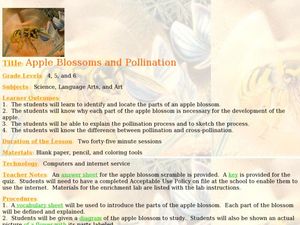Curated OER
Spring Collecting and Identifying Bumble Bees
Students collect bumble bees in the field, record data, identify and release specimens, answer conclusion questions, and send data in to researcher leaders. They make research based conclusions based upon the evidence.
Curated OER
Spring Collecting and Identifying Bumble Bees
Students collect bumble bees in the field, record data, pin and label specimens, answer conclusion questions, and send specimens to research leaders for verification. They improve their ability to work in research teams. Students...
Curated OER
Mini Worlds
In this insects worksheet, students 18 questions regarding butterflies, moths, bees and spiders. A print out version of this worksheet is available, but the online version contains links to various webpages with information on the...
Curated OER
Bees and Wasps
In this biology worksheet, learners look for the details that are common to the insects. Then they label the parts for the two diagrams.
Curated OER
Alternative Animal Agriculture
Eighty slides dealing with the 6 types of farming alternative animals. Specialty producers and the methods that they employ are detailed and some slides deal with the history and origins of farming and the reasons for commerical use.
Curated OER
Scale from the Solar System to a Monster Bee
Sixth graders are introduced to the concept of scale. As a class, they create a model of the solar system taking into account the scale between the planets and the Sun. To end the lesson, they examine "Dina the Monster Bee" and discover...
Curated OER
Structures That Reveal Common Ancestry
Float like a butterfly, sting like a bee, check out wing shapes for common ancestry! Beginning biologists compare wings as analogous structures and discover that environment influences evolution of adaptations. A third activity relies on...
National Wildlife Federation
The Pollinator's Journey: Grades K-8
Bees get all the attention, but so many more creatures contribute to pollination. Scientists explore the role of pollinators as they learn about the parts of a flower and how it reproduces. They discover how plants rely on many different...
Curated OER
Growing Minds: Farm Animal Matching Game
Use this farm animal matching worksheet alongside the Growing Minds Farm Animals lesson plan; kids learn about different animals and the products they are needed for. This activity highlights cows, bees, geese, chickens, goats, sheep,...
Terminix
The Pollinator
What do bees and children have in common? They both love their sweets. Decorate a flower pot or bucket to look like a brightly colored flower and fill it with wrapped candy and cheese puffs. Have learners reach into grab the candy,...
Chicago Botanic Garden
Climate Change Around the World
You know climate change is happening when you see a bee take off its yellow jacket. Part four in a series of five lessons explores all factors affecting climate change: temperature, cloud cover, precipitation, and carbon dioxide. By...
California Academy of Science
The Heat is On: Cause and Effect and Climate
The higher the number of letters in the final word for the National Spelling Bee, the higher the number of people killed by venomous spiders. Obviously, those two facts correlate, but no causation exists. Scholars view data based on...
Curated OER
A Honey of a Hexagon
Students explore how bees make honey and why the hexagon is the best basic pattern for the honeycomb through the use of a video and hands-on activities with honeycombs and geometric shapes.
Curated OER
Pollination
Learners investigate pollination. In this plant biology lesson, students study a diagram of the reproductive parts of the flower and dissect and identify the parts of a real flower.
Curated OER
Apple Blossoms and Pollination
Students explore the concept of pollination. In this pollination lesson plan, students examine the parts of an apple blossom and then compare and contrast pollination and cross-pollination.
Core Knowledge Foundation
Plants Tell It Again!™ Read-Aloud Anthology
A 190-page anthology explores the life and parts of plants, flowers, and trees while boosting reading comprehension skills. Literature and informational texts showcase Johnny Appleseed and George Washington Carver. Lessons follow the...
Curated OER
The Magic School Bus in a Beehive
Young scholars learn along with Ms. Frizzle's class. In this Magic School Bus lesson plan, students dance the Honey-Bee-Bop to communicate the location of hidden flowers.
Curated OER
Pollination Parties
Young scholars discuss the pollination of bees and butterflies. In this pollination instructional activity,students complete a worksheet answering questions about an imaginary bee pollination company. Young scholars understand the...
Curated OER
Plants And Pollination
High schoolers describe sexual reproduction in plants, including the process of pollination, how insects assist in pollination, and how pollination differs from fertilization. They also explore the importance of honey bees to Arizona...
Curated OER
What's All the Buzz About
Students participate in a game of charades to examine different animal behaviors. After reading an article, they discuss why bees waggle and how that behavior applies to humans. They research the behaviors of an animal of interest to...
Curated OER
Human Genetics
In this science worksheet, students read about how many genes are present in tomatoes, fruit flies, humans, worms, and honey bees.
Education Outside
Honey Tasting
Young scientists will be abuzz as they sample and compare the tasty treats produced by Apis Mellifera.
The Science Spot
Flower Basics
Learn about plants and pollination with a worksheet about the parts of a flower. After labeling the anatomy of a flower using a word bank, kids explain the difference between self-pollination and cross-pollination, and unscramble the...
Curated OER
Candlemaking
There might not be a butcher or baker, but you'll have a class full of candlestick makers after a hands-on instructional activity about candles make from beeswax. After a brief history of where beeswax comes from, young artisans craft...
Other popular searches
- Honey Bees
- Secret Life of Bees
- Geography Bee
- Honey Bee Anatomy
- Bumble Bees
- Spelling Bee
- Bees Pollination
- Akeelah and the Bee
- Honeybee
- Bee Colony
- Geography Bee Questions
- Africanized Bees

























